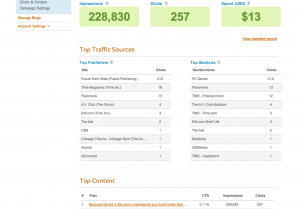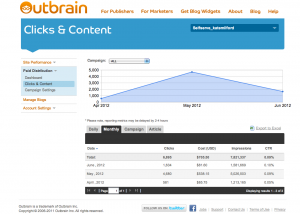Having taken some time to decompress post-Kickstarter, I’m now ready to get moving on a group of posts I’ve been very excited about. In the Toolkit Series, I’ll be talking about some of the services that are making this first volume of the Arcana project possible. This is the first of two posts in which I’ll be talking about Outbrain.
One of the challenges I knew I would have was that I’m a haphazard blogger, and at the time I started the project, my website didn’t get much traffic. I definitely needed to make plans to reach beyond my own circle of contacts. Outbrain is a startup that specializes in driving traffic to web content. Now, full disclosure: I had a lot of time and opportunity to get to know Outbrain, the folks behind it, and how it works because my husband, Nathan, has worked there for three years and is currently the US Operations Manager. I follow Outbrain folks on Twitter, I’ve geeked out over bourbon with Outbrain folks, I’ve even traveled with Outbrain folks (like that time I scored a vacation in Israel by tagging along on one of Nathan’s work trips). Along the way, I’ve gotten a really good sense of the company and what they do, so it was kind of a no-brainer decision to look to Outbrain when it was time to start worrying about how I was going to get people I don’t already know to read about the Arcana project.
I knew I would be using Outbrain’s Amplify Self-Serve program. You choose links to submit through your dashboard, and then those links pop up as recommendations on sites that use Outbrain, too; small sites like mine, as well as bigger, fancier sites like Slate, CNN, USA Today, Mashable, and lots more. You can read this article on Outbrain’s blog to learn a bit more about how their automation and algorithms work to serve up content recommendations, but in a nutshell they do a really good job of pointing folks who are already likely to be interested in what you have to say toward your content.
Before I started, I arranged for a meeting with Natalie Chan, who, apart from being one of my Israel traveling companions, is the Marketing Manager for Self-Serve. The basics are simple enough: you set a budget per day (I started with the minimum, $10) and choose a cost per click (CPC). Each time someone clicks on one of your links, you pay the CPC to Outbrain. You only pay for the clicks you get, so some days you might not spend your entire budget, and other days, your campaign might go offline if you hit your budget limit. I started out at a CPC of $0.15, but over the course of the campaign I adjusted that, as well as my budget, a few times. You can change the elements of your campaign anytime as you see what’s working and what’s not.
So, ten bucks budgeted per day at fifteen cents per click equals 66 clicks per day, or an additional 2000 clicks over the course of the month, assuming I was consistently generating interesting content–meaning I also needed to turn into a better blogger. But more on that later.
 I launched my Outbrain campaign at the same time I launched the Kickstarter campaign, at the beginning of April. At Natalie’s urging, I had ten blog posts pre-written in an effort to set myself up to blog more consistently. I was able to monitor the clicks I was getting via Outbrain in real-time on my dashboard. I could see what my campaign had spent up to that time each day, what links were getting the most traffic, and where they were coming from. If you like metrics, by the way, you will have a good time with the dashboard.
I launched my Outbrain campaign at the same time I launched the Kickstarter campaign, at the beginning of April. At Natalie’s urging, I had ten blog posts pre-written in an effort to set myself up to blog more consistently. I was able to monitor the clicks I was getting via Outbrain in real-time on my dashboard. I could see what my campaign had spent up to that time each day, what links were getting the most traffic, and where they were coming from. If you like metrics, by the way, you will have a good time with the dashboard.
For the first week or so, my campaign underperformed. I got monitoring emails from Outbrain a couple times during that period with suggestions on how to improve things so that I was getting enough clicks to spend my budget each day. I also emailed quite a bit with Natalie during that time, and I learned two things: that the biggest hurdle I was facing was that my titles weren’t compelling enough; and that the posts that people were most interested in were about craft rather than general updates and musings. Throughout the entire campaign, the post that got the most traffic was this one about my beta-reader Emma, titled “Kid Editors: Because the Kid in the Room Understands Your Book Better Than You D0.” That one must have had the best combination of subject matter and title.
By the time May rolled around, I had the combination sort of figured out, and I was getting so many clicks that my ten dollar a day budget was being spent by late morning. I’d added not only links to my own blog posts, but links to each interview I gave on anyone else’s blog and links to blog posts that mentioned The Kairos Mechanism or the Arcana project. I started getting emails from Outbrain suggesting that it might be time to reduce my CPC so that I could get more clicks within my budget. I took a look at the links I was “amplifying” and culled a few that were either not performing well or that were not as relevant, dropped the CPC to $0.10, and upped my budget. This combination resulted in more than 4500 clicks in the month of May and more than 1500 in the first week of June leading up to the end of the Kickstarter campaign.
The net effect is that my blog, which in March, according to Google Analytics, was averaging (are you ready for this humiliating admission?) less than twenty clicks a day, averaged more than 60 clicks in April, 213 in May, and 234 in June until I stopped the campaign on the 10th. For contrast, post-Kickstarter but without Outbrain, my blog has been averaging 85 clicks a day. My total spending for the two months was $705.50. This was more than I had initially budgeted (remember that I had started out with the minimum daily budget of $10/day), but once I was getting so many clicks, I didn’t like seeing the campaign go offline so early in the day, so I decided the extra expense was worth it, especially since the readers who’ve visited the site have also consistently spent more time here, which I believe means I am also getting better engagement with my readers overall.
A side-effect of the campaign, by the way, is that (with the exception of the month I just took off, during which I will admit to having willfully fallen back into my errant ways, but LOOK, I NEEDED A BREAK, OKAY?) I did turn into a better blogger, and that’s pretty much all up to the pep talk I got from Natalie during that first meeting. Another great thing about the folks at Outbrain: they are passionate readers of blogs, and they know what works and what doesn’t. So, without suggesting that I lose anything that I might feel was uniquely part of my own blog-writing voice and style, Natalie was able to help me craft posts that were more likely to get served up as recommendations, and more likely to be read and talked about afterward.
And that bloggy pep-talk will be the subject of Outbrain, Part Two. Stay tuned!
